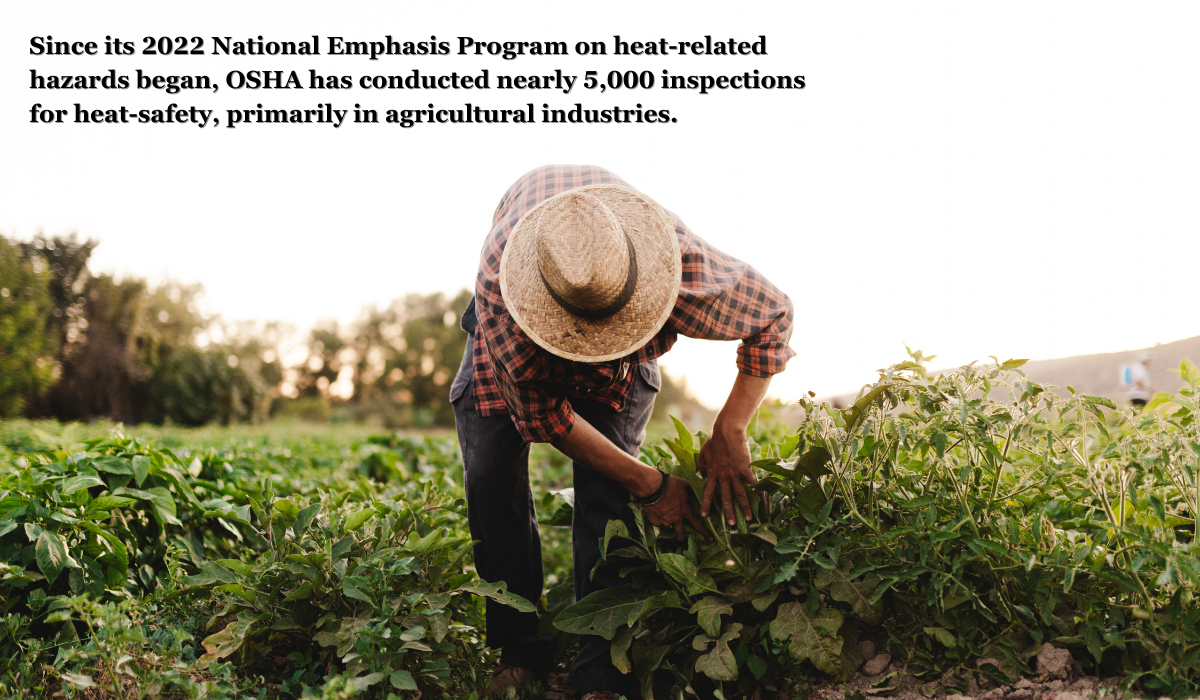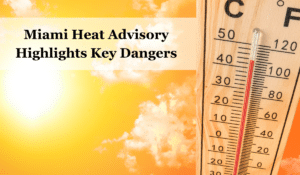Ensuring the safety and well-being of outdoor workers in high-temperature environments is paramount, requiring effective heat protection measures to prevent heat-related illnesses and injuries. And unfortunately, as temperatures continue climbing, it’s a problem on the rise all across the country.
In the latest example, Miami residents were recently faced with extreme temperatures as the city issued its first May heat advisory in 15 years. The Miami-Dade County alert, which took effect from 10am to 8pm on May 17th, 2024, warned of highs in the mid-90s and high temperatures topping 105 degrees.
For those working outdoors, the threat of danger was very real. The symptoms of heat-related illnesses include a range of indicators depending on the severity of the condition.
Heat stroke, the most severe form, can present with a high body temperature (103°F or higher), hot, red, dry, or damp skin, fast, strong pulse, headache, dizziness, nausea, confusion, and loss of consciousness.
On the other hand, heat exhaustion may manifest as heavy sweating, cold, pale, and clammy skin, fast, weak pulse, nausea or vomiting, muscle cramps tiredness or weakness, dizziness, headache, and fainting. Heat cramps are characterized by heavy sweating during intense exercise and muscle pain or spasms.
Let’s take a look at a few heat illness prevention tips to protect your workers as the summer approaches.
Related Article: Dept. of Labor Advances Heat Safety Rulemaking, Intensifies Enforcement
Related Article: OSHA Cites Alabama Company After Heat Illness Related Death

More Extreme Heat Predictions for Summer 2024
In the month of March, scientists from the EU’s Copernicus Climate Change Service reported that February 2024 was the hottest February in their records, which go back to 1940.
This update came on the heels of their earlier report this January that, as expected, 2023 was indeed the hottest year on record.
Towards the end of March, the US National Oceanic and Atmospheric Administration released its spring outlook, forecasting that most of the continental US and Alaska will see above-average temperatures from April through June. It also stated that the risk of flooding will ease during the three-month period because of “historically low winter snow cover” in large parts of the country.
In the month of April, a forecast from the Weather Channel also predicted an “abnormally hot” summer in some parts of the US. NOAA published a map this month showing where it expects the heat to be most extreme compared to normal.
This map highlights a band stretching from the Northwest down through the Southwest and into Texas. Additionally, the Northeast from Maine to Pennsylvania is expected to experience a hotter summer than normal.
The combination of heat and sparse rainfall could increase the risk of drought and wildfires in some regions.
Hotter Weather, Bigger Problems
A key trend highlighted by the US government’s Fifth National Climate Assessment, published in November 2023, was that climate change is provoking extreme weather events across the country that are both more frequent and more severe.
It also pointed to an increase in heat waves and wildfires in the West over the last few decades, the increased drought risk in the Southwest over the past century, and more extreme rainfall east of the Rockies. Hurricanes have also been intensifying, as those who have found themselves in the path of a storm have already experienced.
It’s also noteworthy that extreme weather is going to have a widespread impact on industry, society and individuals. In 2023 alone there were 25 extreme weather events in the U.S, with losses amounting to over $1 billion that resulted in the deaths of 464 people.
“As the climate continues to rise, most areas will be at an increased risk of some types of climate-linked extreme weather,” says Russell Vose, chief of the Monitoring and Assessment Branch at NOAA’s National Centers for Environmental Information and one of the NCA’s authors.
Heat Illness Prevention Tips for Outdoor Workers
These tips encompass a range of preventive measures to safeguard outdoor workers from heat-related illnesses and promote a safe working environment in high-temperature conditions.
- Hydration: Ensure outdoor workers drink plenty of water to stay hydrated throughout the day.
- Acclimatization: Allow workers to gradually get used to weather conditions to prevent heat-related illnesses.
- Scheduled Rest: Implement schedules that alternate work with rest periods to avoid overexertion in high temperatures.
- Training: Provide comprehensive training for workers and supervisors on heat illness prevention measures.
- Access to Shade: Ensure access to shaded areas for employees to cool down and rest during breaks.
- Identify Hot Environments: Recognize and identify hot environments, whether indoors or outdoors, to take necessary precautions.
- Cool-Down Rest: Encourage workers to take cool-down breaks in the shade for at least 5 minutes to prevent heat-related illnesses.
- Written Prevention Plan: Develop and implement a written prevention plan that includes specific measures to reduce the risk of heat illness.
- Compliance with Regulations: Ensure compliance with heat illness prevention regulations, such as those outlined by OSHA, to protect outdoor workers effectively.
- Appropriate PPE: While steps like frequent breaks, proper hydration, and providing shade are basic actions you can use to help your team, personal protective equipment can go a long way towards comfort and safety for your workers.
For further information on summer heat safety, check out some of these resources on OSHA guidelines and rules to help you keep your employees and worksite safe:
- Heat Injury and Illness Prevention in Outdoor and Indoor Work Settings
- Water. Rest. Shade
- National Emphasis Program – Outdoor and Indoor Heat-Related Hazards
National Emphasis Program on Heat-Related Hazards
As mentioned in a recent article, OSHA’s National Emphasis Program on Outdoor and Indoor Heat-Related Hazards, initiated in 2022, focuses on conducting proactive inspections in workplaces with high heat exposures to prevent injuries, illnesses, and fatalities.
Since its inception, OSHA has conducted nearly 5,000 federal inspections related to heat hazards. Furthermore, the agency is prioritizing inspections in agricultural industries that employ temporary H-2A workers, who are particularly vulnerable to heat-related risks due to various factors such as language barriers and lack of acclimatization.
Further, OSHA is actively in the process of creating a specific heat safety standard, which in the eyes of many, is long overdue.
Key Takeaways
The occupational health risks associated with the extreme heat in Miami highlights the importance of implementing proper safety measures for workers exposed to high temperatures.
As an employer, make sure you have heat illness prevention programs in place, provide adequate hydration, rest breaks, and shade or cooling areas. Additionally, make sure to train your team to recognize and respond to heat-related illnesses.
By prioritizing occupational health and safety, you can ensure the well-being of your workforce during this challenging period.
Stay In Compliance With Worksite Medical
In most cases, OSHA requires medical surveillance testing, and at no cost to employees.
Worksite Medical makes that program easier with mobile medical testing.
Additionally, we conduct drug & alcohol screenings, on-site respirator fit tests, as well as audiometric exams, pulmonary function tests and heavy metal lab work, right on your job site. We also keep accurate, easy-to-access medical records for your convenience. You’ll keep your employees at work, and stay ahead of OSHA inspections.
With Worksite Medical, a mobile medical testing unit — we can bring all the resources of a lab to you. Our certified lab technicians can perform both qualitative and quantitative respirator tests to ensure a perfect fit.
Protect your team and your workplace now with Worksite Medical. Not sure what you need? Try our medical testing wizard here.
Give us a call at 1-844-622-8633, or complete the form below to schedule an on-site visit or to get your free quote.




